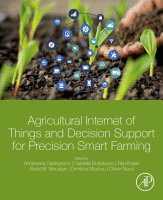Browse content
Table of contents
Actions for selected chapters
- Full text access
- Book chapterAbstract only
Chapter 1 - Introduction to agricultural IoT
Lucio Colizzi, Danilo Caivano, ... Hongling Shi
Pages 1-33 - Book chapterAbstract only
Chapter 2 - Monitoring
A.M. Mouazen, Thomas Alexandridis, ... Kenneth A. Sudduth
Pages 35-138 - Book chapterAbstract only
Chapter 3 - Data processing
Annamaria Castrignanò and Gabriele Buttafuoco
Pages 139-182 - Book chapterAbstract only
Chapter 4 - Support to decision-making
Olivier Naud, James Taylor, ... Bruno Tisseyre
Pages 183-224 - Book chapterAbstract only
Chapter 5 - Smart action
Puwadol Oak Dusadeerungsikul, Vasileios Liakos, ... Avital Bechar
Pages 225-277 - Book chapterAbstract only
Chapter 6 - Economic, environmental and social impacts
S.M. Pedersen, M.F. Pedersen, ... A.M. Mouazen
Pages 279-330 - Book chapterAbstract only
Chapter 7 - Precision farming and IoT case studies across the world
Guido Fastellini and Calogero Schillaci
Pages 331-415 - Book chapterNo access
Subject Index
Pages 417-434 - Book chapterNo access
Author Index
Pages 435-459
About the book
Description
Agricultural Internet of Things and Decision Support for Smart Farming reveals how a set of key enabling technologies (KET) related to agronomic management, remote and proximal sensing, data mining, decision-making and automation can be efficiently integrated in one system. Chapters cover how KETs enable real-time monitoring of soil conditions, determine real-time, site-specific requirements of crop systems, help develop a decision support system (DSS) aimed at maximizing the efficient use of resources, and provide planning for agronomic inputs differentiated in time and space. This book is ideal for researchers, academics, post-graduate students and practitioners who want to embrace new agricultural technologies.
Agricultural Internet of Things and Decision Support for Smart Farming reveals how a set of key enabling technologies (KET) related to agronomic management, remote and proximal sensing, data mining, decision-making and automation can be efficiently integrated in one system. Chapters cover how KETs enable real-time monitoring of soil conditions, determine real-time, site-specific requirements of crop systems, help develop a decision support system (DSS) aimed at maximizing the efficient use of resources, and provide planning for agronomic inputs differentiated in time and space. This book is ideal for researchers, academics, post-graduate students and practitioners who want to embrace new agricultural technologies.
Key Features
- Presents the science behind smart technologies for agricultural management
- Reveals the power of data science and how to extract meaningful insights from big data on what is most suitable based on individual time and space
- Proves how advanced technologies used in agriculture practices can become site-specific, locally adaptive, operationally feasible and economically affordable
- Presents the science behind smart technologies for agricultural management
- Reveals the power of data science and how to extract meaningful insights from big data on what is most suitable based on individual time and space
- Proves how advanced technologies used in agriculture practices can become site-specific, locally adaptive, operationally feasible and economically affordable
Details
ISBN
978-0-12-818373-1
Language
English
Published
2020
Copyright
Copyright © 2020 Elsevier Inc. All rights reserved.
Imprint
Academic Press
